An Efficient Resource Allocation for Massive MTC in NOMA-OFDMA Based Cellular Networks
Abstract
1. Introduction
- We propose a NOMA-based congestion-alleviating access scheme (NCAS) to improve the access capacity and resource efficiency accompanied with OFDMA-based congestion-alleviating access scheme (OCAS) for the hybrid NOMA-OFDMA based cellular M2M communication systems. The MTCDs in NCAS and OCAS are allowed to send data with optimal power allocation solution right after preamble transmission without explicitly establishing a connection, which could reduce the scheduling signaling overhead and simplify the access process. Different from OCAS, a device called cluster head (CH) transmit preambles in NCAS, so that the number of MTCDs that directly transmit preambles to the BS can be greatly reduced.
- We propose a traffic-aware resource blocks (RBs) allocation scheme consisting of two sub-problems for the hybrid multiple access systems. The first sub-problem is used to optimize RBs allocation between PRACH and PUSCH given the sum of RBs allocated to PRACH and PUSCH for NCAS, while the second one optimizes the RBs allocation between NCAS and OCAS. NOMA based MTCDs and OFDMA based MTCDs, respectively, compete for uplink resources allocated for NCAS and OCAS to transmit preamble and data packets. To alleviate the RA congestion problem, the number of MTCDs that compete for uplink resources allocated for NCAS and OCAS are restricted by the traffic-aware access barring schemes.
- We formulate an energy efficiency maximization problem such that the MTCDs’ power allocation can be optimized under the maximum transmit power constraint and QoS requirement of the MTCD. The feasibility conditions of the power allocation solution are determined as linear constraints of the CH. The original non-convex optimization problem is transformed into the pseudo-concave function of the CH by using the difference of received power. Then the transformed problem is solved under the feasibility conditions by two iterative algorithms. The first algorithm is used to optimize the energy efficiency by using the Dinkelbach method, while the second one optimizes the power allocation solution under the energy efficiency optimized in the first algorithm.
- We design a device clustering scheme to group devices into different clusters. The proposed scheme provides the range of channel gain differences as the condition of grouping, which exploits the channel gain and maximum transmit power constraint of the devices. If the channel gain differences among devices can satisfy the condition of grouping, then these devices are treated as NOMA based MTCDs, which compete for uplink resources allocated for NCAS. Otherwise, these devices are treated as OFDMA based MTCDs, which compete for uplink resources allocated for OCAS.
- We evaluate the energy efficiency and access capacity performance of the resource allocation for the hybrid NOMA-OFDMA based cellular M2M communication systems. Simulation results show that the proposed resource allocation scheme can efficiently improve the system access capacity and energy efficiency compared with NORA-DT.
2. System Model and NOMA Based Congestion-Alleviating Access Scheme
2.1. System Model
2.2. NOMA Based Congestion-Alleviating Access Scheme
3. Optimization of the Number of RBs for the Hybrid NOMA-OFDMA Based M2M Communications
3.1. Optimization of the Number of RBs for the PRACH Given the Number of RBs for the NCAS
| Algorithm 1 RBs Allocation for PRACH for the NCAS | |
| 1: | Initialize q, , , . |
| 2: | for to do |
| 3: | Calculating and based on Proposition 1. |
| 4: | Calculating based on Proposition 2. |
| 5: | if then |
| 6: | ; |
| 7: | end if |
| 8: | end for |
| 9: | , . |
| 10: | if, then |
| 11: | , . (See Appendix A.) |
| 12: | end if |
| 13: | ifthen |
| 14: | , . |
| 15: | end if |
| 16: | ifthen |
| 17: | , . (See Appendix B.) |
| 18: | end if |
3.2. Optimization of the Number of RBs for the Hybrid NOMA-OFDMA Based M2M Communications
| Algorithm 2 Optimal RBs allocation factor between NCAS and OCAS | |
| 1: | Initialize , . . |
| 2: | Calculating by Algorithm 1 when . |
| 3: | while and do |
| 4: | . Calculating by Algorithm 1, and let . |
| 5: | for to do |
| 6: | . |
| 7: | end for |
| 8: | for to do |
| 9: | if then |
| 10: | for to do |
| 11: | if then |
| 12: | if then |
| 13: | , , . |
| 14: | end if |
| 15: | end if |
| 16: | end for |
| 17: | end if |
| 18: | end for |
| 19: | . |
| 20: | end while |
4. Channel Model and Problem Formulation
4.1. Channel Model
4.2. Problem Formulation
5. Power Allocation for the Hybrid NOMA-OFDMA Based Cellular M2M Communication Systems
5.1. Feasibility Condition
5.2. Power Allocation for EE Maximization
| Algorithm 3 The Dinkelbach’s algorithm | |
| 1: | Initialize , error tolerance . |
| 2: | repeat |
| 3: | Solve the equivalent problem (40) for a given to obtain the solution ; s.t. (39b), (39c). |
| 4: | . |
| 5: | . |
| 6: | until |
| Algorithm 4 The algorithm for solving problem (39a). | |
| 1: | Initialize . |
| 2: | while 1 do |
| 3: | . |
| 4: | . |
| 5: | if then |
| 6: | . |
| 7: | else if then |
| 8: | . |
| 9: | else |
| 10: | . |
| 11: | end if |
| 12: | if then |
| 13: | ; |
| 14: | end if |
| 15: | end while |
5.3. Computational Complexity Analysis
6. NOMA Clustering Strategy
| Algorithm 5 MTCD Clustering Algorithm | |
| 1: | Initialize , , , and . . |
| 2: | whiledo |
| 3: | . , . . . |
| 4: | if then |
| 5: | for to do |
| 6: | if then |
| 7: | Add MTCD j to the k-th cluster, and remove MTCD j from . |
| 8: | . . |
| 9: | . |
| 10: | ; |
| 11: | else |
| 12: | Remove MTCD j from . |
| 13: | end if |
| 14: | end for |
| 15: | end if |
| 16: | if then |
| 17: | for to do |
| 18: | if and then |
| 19: | Add MTCD j to the k-th cluster, and remove MTCD j from . |
| 20: | . |
| 21: | ; |
| 22: | else |
| 23: | Remove MTCD j from . |
| 24: | end if |
| 25: | end for |
| 26: | end if |
| 27: | end while |
7. Performance Evaluation
8. Conclusions
Author Contributions
Funding
Conflicts of Interest
Appendix A
Appendix B
References
- Islam, M.; Taha, A.E.; Akl, S. A Survey of Access Management Techniques in Machine Type Communications. IEEE Commun. Mag. 2014, 52, 74–81. [Google Scholar] [CrossRef]
- Xia, N.; Chen, H.-H.; Yang, C.-S. Radio resource management in machine-to-machine communications—A survey. IEEE Commun. Surv. Tuts. 2018, 20, 791–828. [Google Scholar] [CrossRef]
- Ding, F.; Su, R.; Tong, E.; Zhang, D.; Zhu, H.; Ismail, M.W.M. Toward a M2M-Based Internet of Vehicles Framework for Wireless Monitoring Applications. IEEE Access 2018, 6, 67699–67708. [Google Scholar] [CrossRef]
- Zhou, Z.; Guo, Y.; He, Y.; Zhao, X.; Bazzi, W.M. Access Control and Resource Allocation for M2M Communications in Industrial Automation. IEEE Trans. Ind. Inf. 2019, 15, 3093–3103. [Google Scholar] [CrossRef]
- Osseiran, A.; Monserrat, J.F.; Marsch, Y.P. 5G Mobile and Wireless Communications Technology; Cambridge University Press: Cambridge, UK, 2016. [Google Scholar]
- Ranken, M. M2M Global Forecast and Analysis 2014-24; Strategy Report; Machina Research: Stamford, CT, USA, 2015. [Google Scholar]
- Hasan, M.; Hossain, E.; Niyato, D. Random access for machine-to-machine communication in LTE-advanced networks: Issues and approaches. IEEE Commun. Mag. 2013, 51, 86–93. [Google Scholar] [CrossRef]
- Lien, S.-Y.; Chen, K.-C.; Lin, Y. Toward Ubiquitous Massive Accesses in 3GPP Machine-to-Machine Communications. IEEE Commun. Mag. 2011, 49, 66–74. [Google Scholar] [CrossRef]
- Boccardi, F.; Heath, R.W.; Lozano, A.; Marzetta, T.L. Petar PopovskiFive disruptive technology directions for 5G. IEEE Commun. Mag. 2014, 52, 74–80. [Google Scholar] [CrossRef]
- Leyva-Mayorga, I.; Tello-Oquendo, L.; Pla, V.; Martinez-Bauset, J.; Casares-Giner, V. On the accurate performance evaluation of the LTE-A random access procedure and the access class barring scheme. IEEE Trans. Wirel. Commun. 2017, 16, 7785–7799. [Google Scholar] [CrossRef]
- Tello-Oquendo, L.; Leyva-Mayorga, I.; Pla, V.; Martinez-Bauset, J.; Vidal, J.-R.; Casares-Giner, V.; Guijarro, L. Performance analysis and optimal access class barring parameter configuration in LTE-A networks with massive M2M traffic. IEEE Trans. Veh. Technol. 2017, 67, 3505–3520. [Google Scholar] [CrossRef]
- Tello-Oquendo, L.; Vidal, J.-R.; Pla, V.; Guijarro, L. Dynamic access class barring parameter tuning in LTE-A networks with massive M2M traffic. In Proceedings of the 17th Annual Mediterranean Ad Hoc Networking Workshop (Med-Hoc-Net), Capri, Italy, 20–22 June 2018. [Google Scholar]
- Zhan, W.; Dai, L. Massive random access of Machine-to-Machine communications in LTE networks: Modeling and throughput optimization. IEEE Trans. Wirel. Commun. 2018, 17, 2771–2785. [Google Scholar] [CrossRef]
- Di, C.; Zhang, B.; Liang, Q.; Li, S.; Guo, Y. Learning Automata-Based Access Class Barring Scheme for Massive Random Access in Machine-to-Machine Communications. IEEE Internet Things J. 2019, 6, 6007–6017. [Google Scholar] [CrossRef]
- Lee, K.; Jang, J.W. An Efficient Contention Resolution Scheme for Massive IoT Devices in Random Access to LTE-A Networks. IEEE Access 2018, 6, 67118–67130. [Google Scholar] [CrossRef]
- Alavikia, Z.; Ghasemi, A. Collision-Aware Resource Access Scheme for LTE-Based Machine-to-Machine Communications. IEEE Trans. Veh. Technol. 2018, 67, 4683–4688. [Google Scholar] [CrossRef]
- Zhen, L.; Qin, H.; Zhang, Q. Optimal Preamble Design in Spatial Group-Based Random Access for Satellite-M2M Communications. IEEE Wirel. Commun. Lett. 2019, 8, 953–956. [Google Scholar] [CrossRef]
- Zhao, X.; Wang, C.; Wang, W. Dynamic Preamble Grouping and Access Control Scheme in Machine-to-Machine Communication. In Proceedings of the 11th International Conference on Wireless Communications and Signal Processing (WCSP), Xi’an, China, 23–25 October 2019. [Google Scholar]
- Wan, C.; Sun, J. Access Class Barring Parameter Adaptation Based on Load Estimation Model for mMTC in LTE-A. In Proceedings of the 2019 International Conference on Communications, Information System and Computer Engineering (CISCE), Haikou, China, 5–7 July 2019. [Google Scholar]
- Vilgelm, M.; Grsu, H.M.; Kellerer, W.; Reisslein, M. LATMAPA: Load-Adaptive Throughput-MAximizing preamble allocation for prioritization in 5G Random Access. IEEE Access 2017, 5, 1103–1116. [Google Scholar] [CrossRef]
- Wiriaatmadja, D.T.; Choi, K.W. Hybrid Random Access and Data Transmission Protocol for Machine-to-Machine Communications in Cellular Networks. IEEE Trans. Wirel. Commun. 2015, 14, 33–46. [Google Scholar] [CrossRef]
- Zhang, Z.; Sun, H.; Hu, R.Q.; Zhang, X.; Xu, W.; Fan, P. Downlink and uplink non-orthogonal multiple access in a dense wireless network. IEEE J. Sel. Areas Commun. 2017, 35, 2771–2784. [Google Scholar] [CrossRef]
- Islam, S.M.R.; Avazo, N.; Dobre, O.A.; Kwak, K.-S. Power-domain non-orthogonal multiple access (NOMA) in 5G systems: Potentials and challenges. IEEE Commun. Surveys Tuts. 2017, 19, 721–741. [Google Scholar] [CrossRef]
- Gao, Y.; Xia, B.; Xiao, K.; Chen, Z.; Li, X.; Zhang, S. Theorectical analysis of the dynamic decode ordering SIC receiver for uplink NOMA systems. IEEE Commun. Lett. 2017, 21, 2246–2249. [Google Scholar] [CrossRef]
- Ali, M.S.; Tabassum, H.; Hossain, E. Dynamic user clustering and power allocation for uplink and downlink non-orthogonal multiple access (NOMA) systems. IEEE Access 2016, 4, 6325–6343. [Google Scholar] [CrossRef]
- Lv, T.; Ma, Y.; Zeng, J.; Mathiopoulos, P.T. Millimeter-Wave NOMA Transmission in Cellular M2M Communications for Internet of Things. IEEE Internet Things J. 2018, 5, 1989–2000. [Google Scholar] [CrossRef]
- Cabrera, E.; Vesilo, R. An Enhanced K-means Clustering Algorithm with Non-Orthogonal Multiple Access (NOMA) for MMC Networks. In Proceedings of the 28th International Telecommunication Networks and Applications Conference (ITNAC), Sydney, NSW, Australia, 21–23 November 2018. [Google Scholar]
- Liang, Y.; Li, X.; Martin, H. Non-Orthogonal Multiple Access (NOMA) in Uplink Poisson Cellular Networks With Power Control. IEEE Trans. Commun. 2019, 67, 8021–8036. [Google Scholar] [CrossRef]
- Yang, Z.; Xu, W.; Pan, Y.; Pan, C.; Chen, M. Energy efficient resource allocation in machine-to-machine communications with multiple access and energy harvesting for IoT. IEEE Internet Things J. 2018, 5, 229–245. [Google Scholar] [CrossRef]
- Zeng, M.; Hao, W.; Dobre, O.A.; Poor, H.V. Energy-Efficient Power Allocation in Uplink mmWave Massive MIMO with NOMA. IEEE Trans. Veh. Technol. 2019, 3, 3000–3004. [Google Scholar] [CrossRef]
- Gu, B.; Zhang, C.; Wang, H.; Yao, Y.; Tan, X. Power control for cognitive M2M communications underlaying cellular with fairness concerns. IEEE Access 2019, 7, 80789–80799. [Google Scholar] [CrossRef]
- Li, Z.; Gui, J. Energy-Efficient Resource Allocation With Hybrid TDMA-NOMA for Cellular-Enabled Machine-to-Machine Communications. IEEE Access 2019, 7, 105800–105815. [Google Scholar] [CrossRef]
- Na, Z.; Zhang, M.; Jia, M.; Xiong, M.; Gao, Z. Joint Uplink and Downlink Resource Allocation for the Internet of Things. IEEE Access 2018, 7, 15758–15766. [Google Scholar] [CrossRef]
- Liang, Y.; Li, X.; Zhang, J.; Ding, Z. Non-orthogonal random access for 5G networks. IEEE Trans. Wireless Commun. 2017, 16, 4817–4831. [Google Scholar] [CrossRef]
- Bai, J.; Li, Y.; Guo, X. Resource Allocation in Non-Orthogonal Random Access for M2M Communications. In Proceedings of the 87th Vehicular Technology Conference (VTC Spring), Porto, Portugal, 3–6 June 2018. [Google Scholar]
- 3GPP. Physical Layer Procedures; Technical Report for TS 36.213; 3rd Generation Partnership Project (3GPP): Sophia Antipolis, France, 2016. [Google Scholar]
- 3GPP. Physical Channels Modulation; Technical Report for TS 36.211; 3rd Generation Partnership Project(3GPP): Sophia Antipolis, France, 2016. [Google Scholar]
- 3GPP. Study on RAN Improvements for Machine-Type Communications; Technical Report for TR 37.868; 3rd Generation Partnership Project(3GPP): Sophia Antipolis, France, 2011. [Google Scholar]
- Roche, G.; Glazunov, A.; Allen, B. LTE-Advanced and Next Generation Wireless Networks Channel Modelling and Propagation; John Wiley & Sons: Hoboken, NJ, USA, 2012; pp. 35–40. [Google Scholar]
- Zhang, N.; Wang, J.; Kang, G.; Liu, Y. Uplink Nonorthogonal Multiple Access in 5G Systems. IEEE Commun. Lett. 2016, 20, 458–461. [Google Scholar] [CrossRef]
- Li, Y.; Sheng, M.; Yang, C.; Wang, X. Energy efficiency and spectral efficiency tradeoff in interference-limited wireless networks. IEEE Commun. Lett. 2013, 17, 1924–1927. [Google Scholar] [CrossRef]
- Saraereh, O.A.; Alsaraira, A.; Khan, I.; Uthansakul, P. An Efficient Resource Allocation Algorithm for OFDM-Based NOMA in 5G Systems. Electronics 2019, 8, 1399. [Google Scholar] [CrossRef]
- Ding, Z.; Yang, Z.; Fan, P.; Poor, H.V. On the performance of non-orthogonal multiple access in 5G systems with randomly deployed users. IEEE Signal Process. Lett. 2014, 21, 1501–1505. [Google Scholar] [CrossRef]
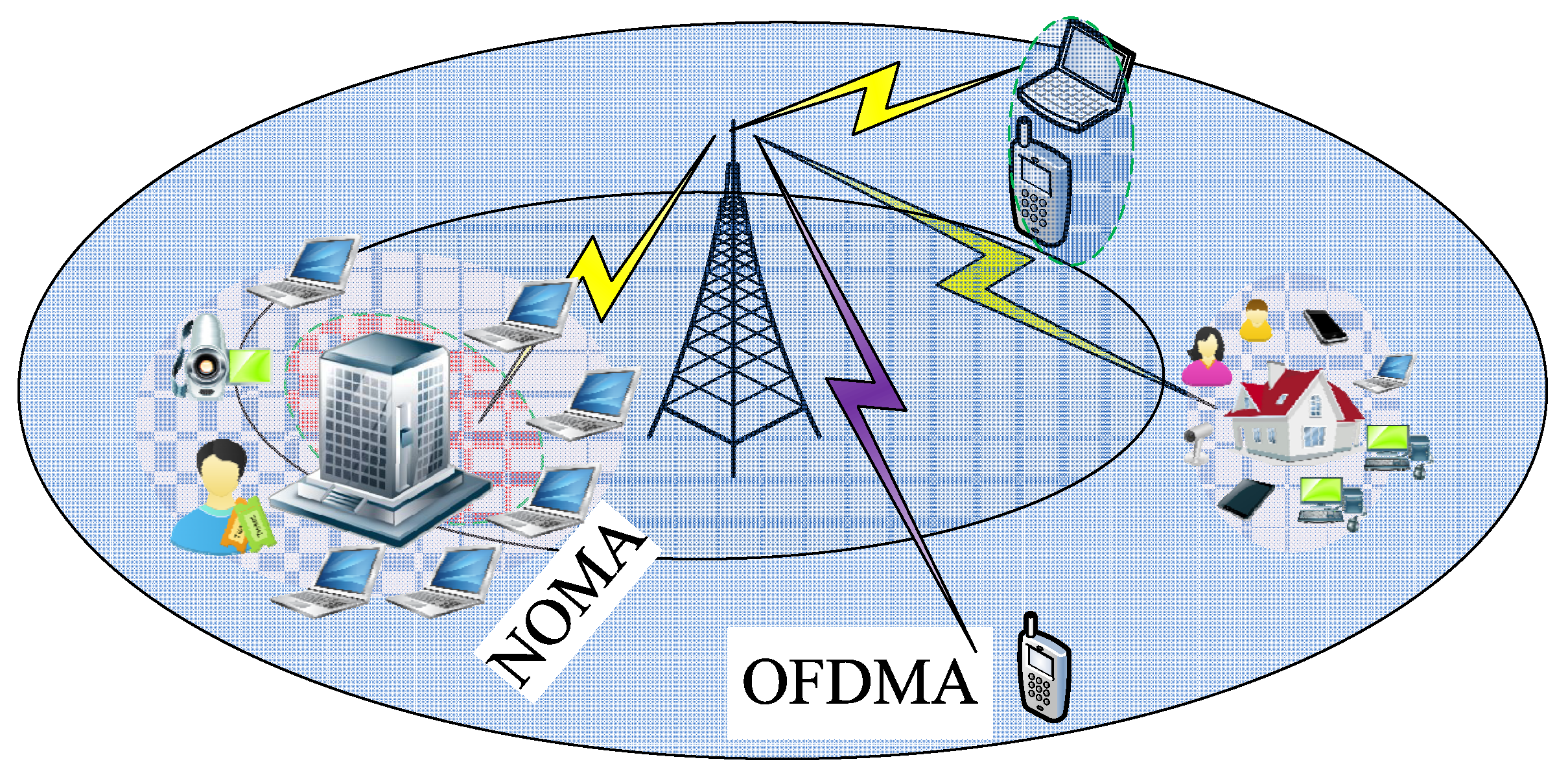
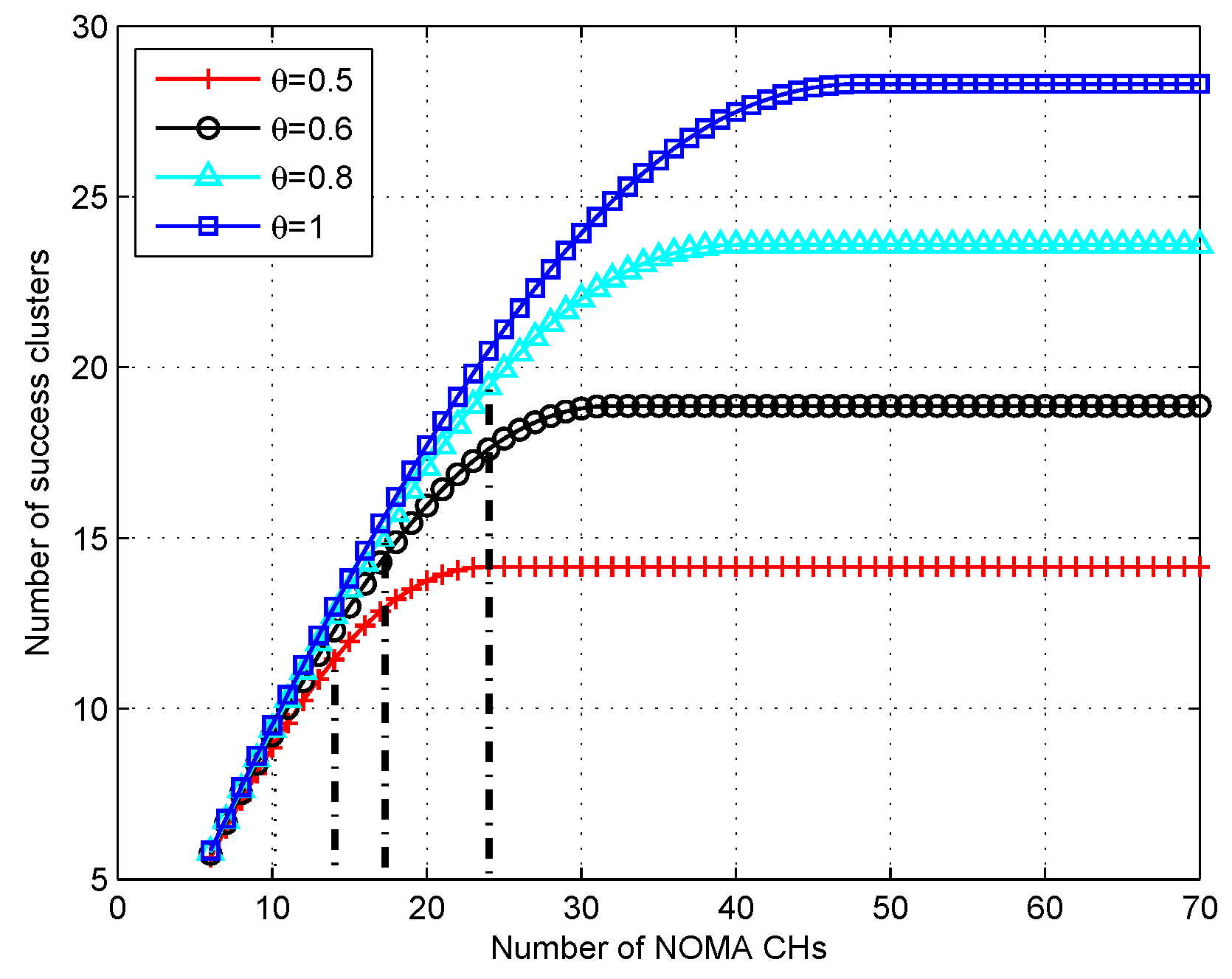

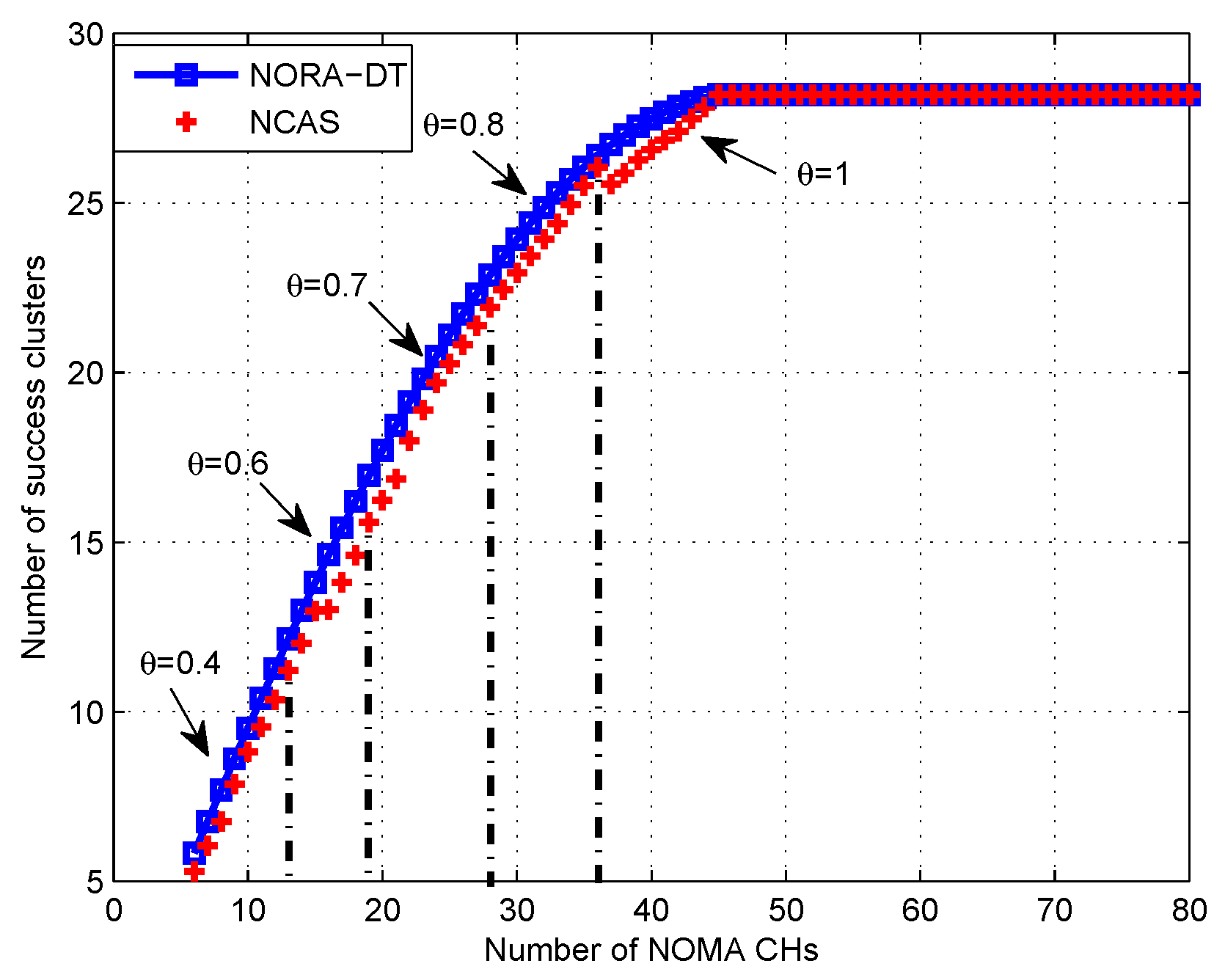
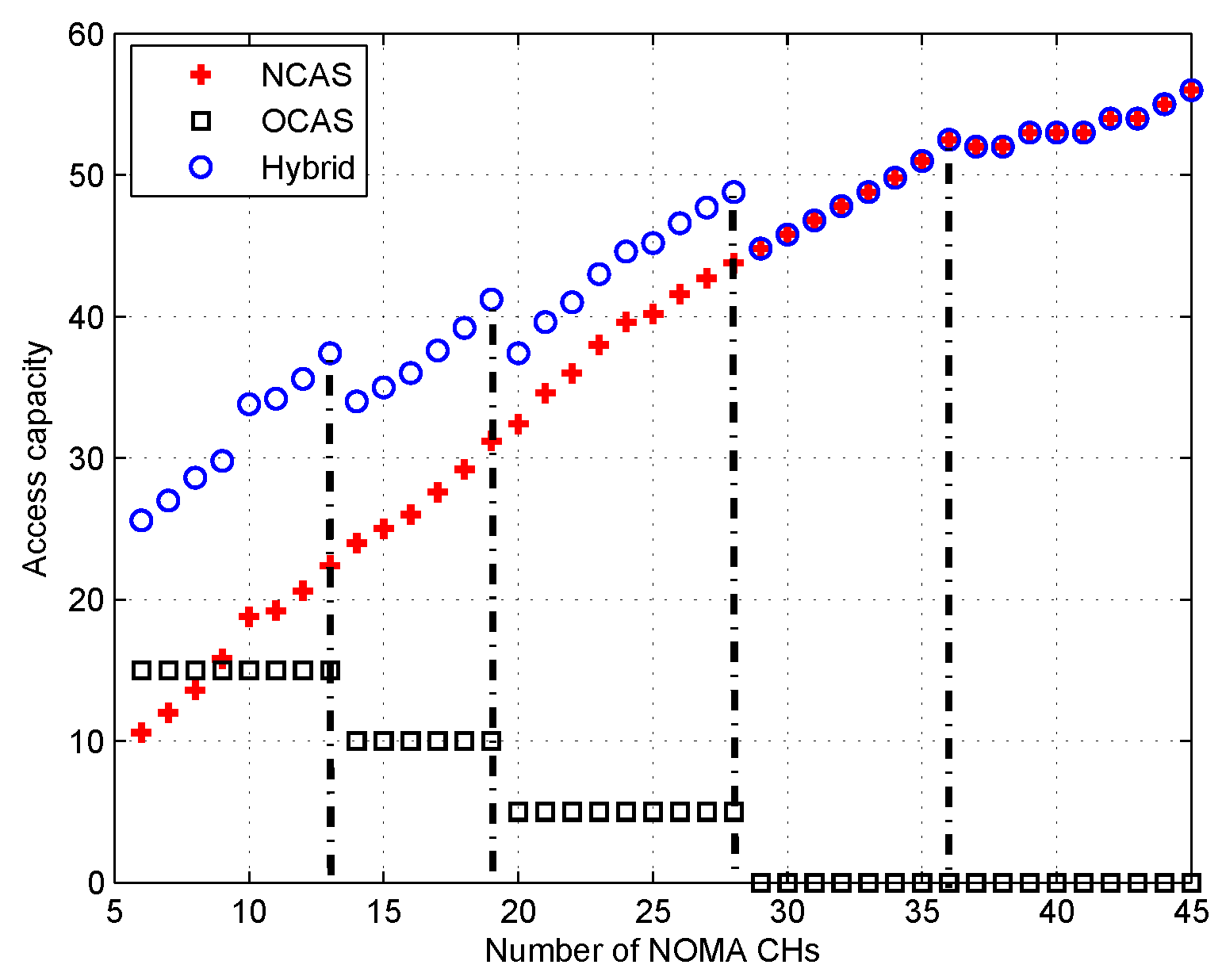


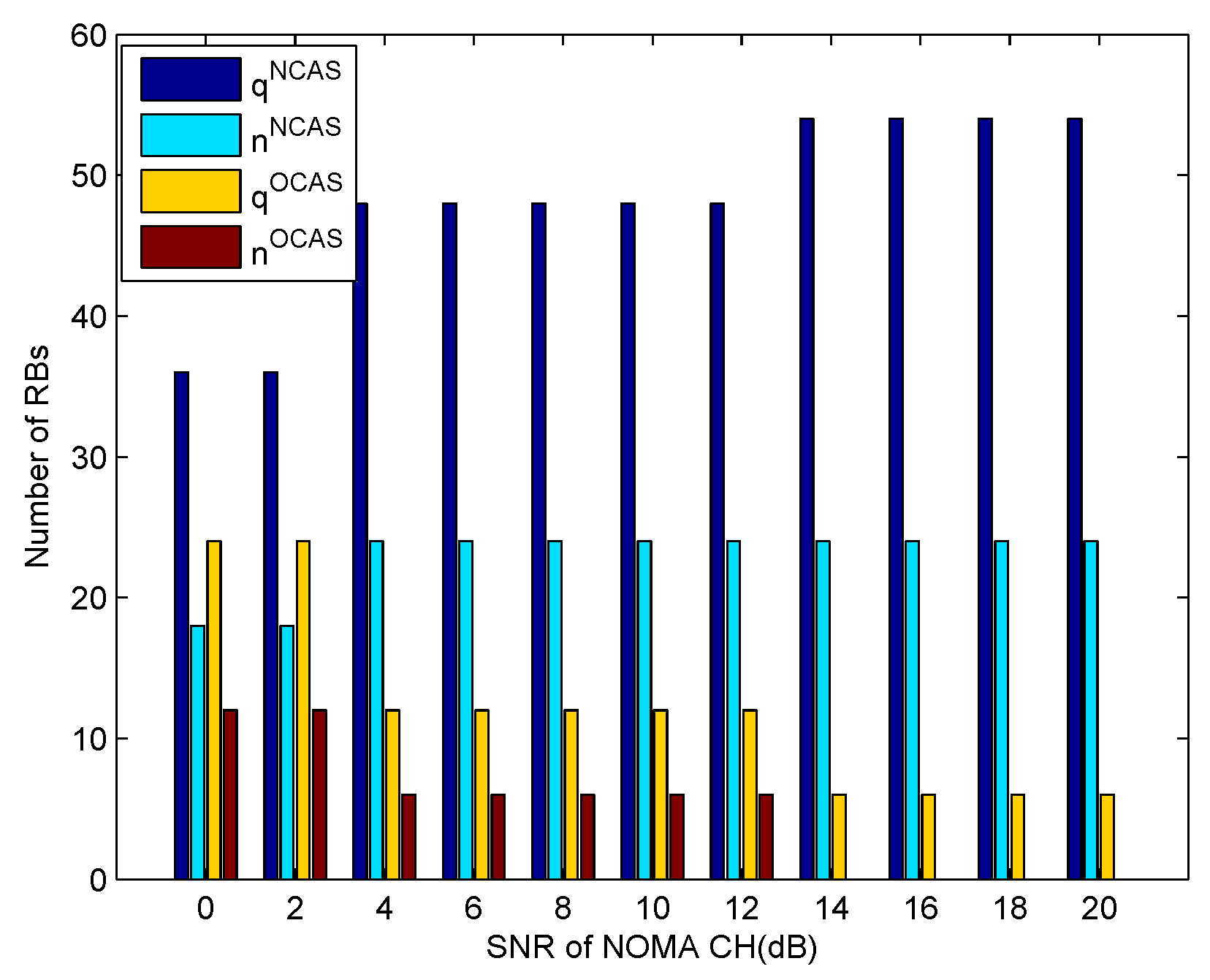

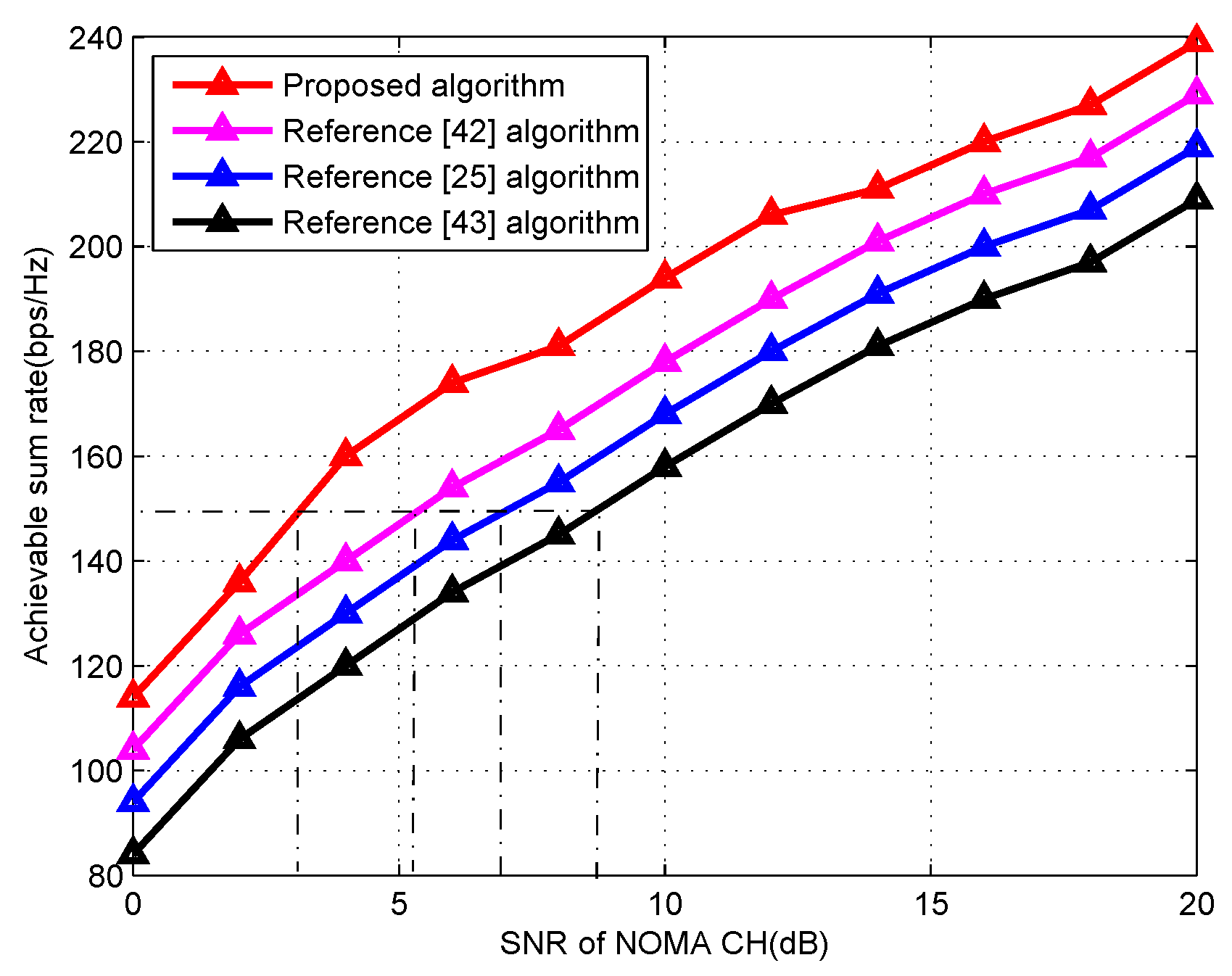
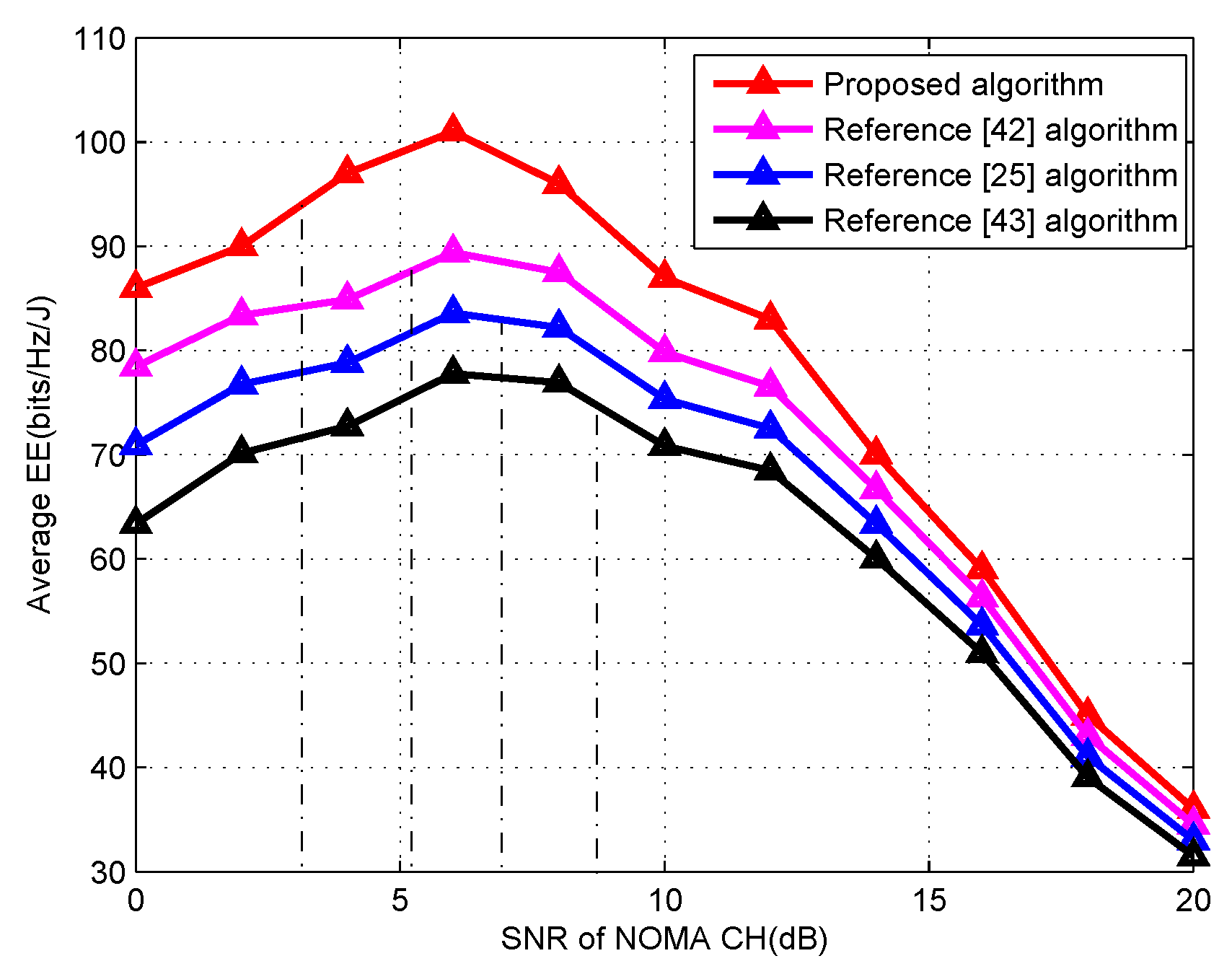
| Parameters | Value |
|---|---|
| System bandwidth | 20 MHz |
| Bandwidth of a RB | 180 KHz |
| Number of available RBs, q | 60 |
| Number of preambles mapped to one PRACH, | 24 |
| Number of RBs constituting one PUSCH, | 1 |
| Maximum transmission power | dBm |
| Minimum data rate | bps |
| Number of multiplexing MTCD | 2 |
| Variance of additive noise | 0 dB |
© 2020 by the authors. Licensee MDPI, Basel, Switzerland. This article is an open access article distributed under the terms and conditions of the Creative Commons Attribution (CC BY) license (http://creativecommons.org/licenses/by/4.0/).
Share and Cite
Wu, Y.; Zhang, S.; Liu, Z.; Liu, X.; Li, J. An Efficient Resource Allocation for Massive MTC in NOMA-OFDMA Based Cellular Networks. Electronics 2020, 9, 705. https://doi.org/10.3390/electronics9050705
Wu Y, Zhang S, Liu Z, Liu X, Li J. An Efficient Resource Allocation for Massive MTC in NOMA-OFDMA Based Cellular Networks. Electronics. 2020; 9(5):705. https://doi.org/10.3390/electronics9050705
Chicago/Turabian StyleWu, Yali, Shuang Zhang, Zhengxuan Liu, Xiaoshuang Liu, and Jianfeng Li. 2020. "An Efficient Resource Allocation for Massive MTC in NOMA-OFDMA Based Cellular Networks" Electronics 9, no. 5: 705. https://doi.org/10.3390/electronics9050705
APA StyleWu, Y., Zhang, S., Liu, Z., Liu, X., & Li, J. (2020). An Efficient Resource Allocation for Massive MTC in NOMA-OFDMA Based Cellular Networks. Electronics, 9(5), 705. https://doi.org/10.3390/electronics9050705





